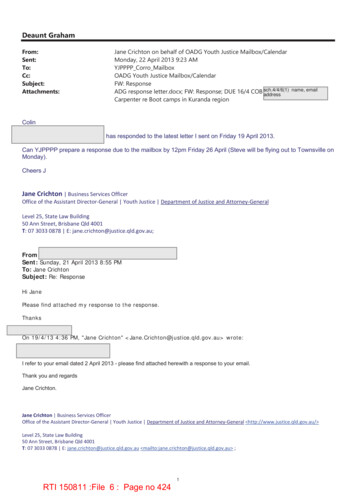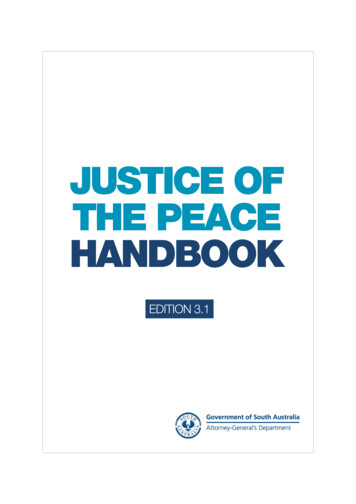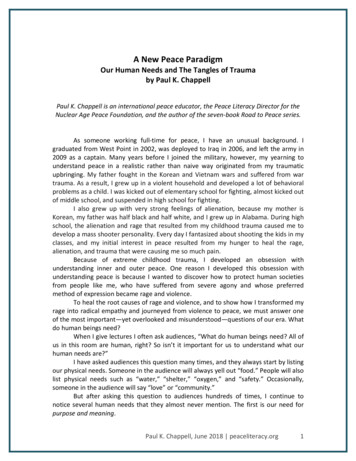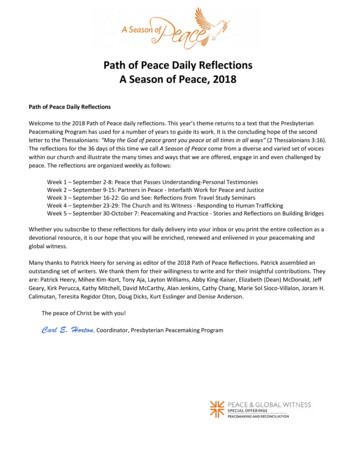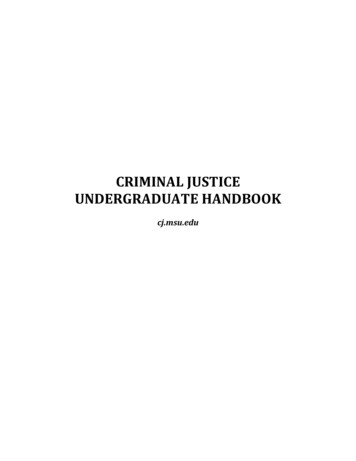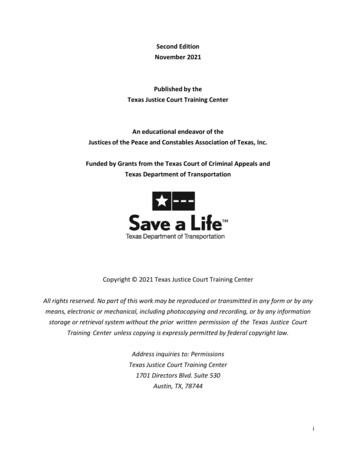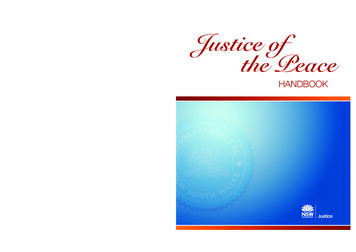
Transcription
Justice ofthe PeaceHANDBOOK
“ I will do right to all manner of people, after thelaws and usages of the State of New South Wales,without fear or favour, affection, or ill-will.”Extract from the Oaths of Office for appointmentas a Justice of the Peace in NSW State of New South Wales through the Department of Justice 2013, revised 2017. You maycopy, distribute, display, download and otherwise freely deal with this work for any purpose,provided that you attribute the Department of Justice as the owner. However, you must obtainpermission if you wish to (a) charge others for access to the work (other than at cost), (b) includethe work in advertising or a product for sale, or (c) modify the work.This document has been prepared by the Department of Justice. It constitutes the guidelinesissued by the Minister under section 8(2) of the Justices of the Peace Act 2002. While every carehas been taken in relation to its accuracy, no warranty is given or implied. Further, it containsguidelines only and does not constitute legal advice. Persons making a decision about their legalrights and obligations in relation to matters addressed in this document should obtain their ownindependent advice and should not rely on this document to make a decision. The Department ofJustice does not endorse or take responsibility for the contents of any publications that arereferred to in this document which are not produced by the Department of Justice.This document is available on the website www.jp.nsw.gov.au and can be provided in alternativeformats such as Braille, audiotape, large print or computer disk.For alternative formats contact: Appointments Services, Department of Justice,phone: (02) 8688 7487, TTY: (02) 8688 7733 (for people who are deaf or have a speechimpairment), email: jp@justice.nsw.gov.auState of New South Wales through the Department of Justice January 2017. You may freely dealwith this work for any purpose other than profit. For more information email jp@justice.nsw.gov.auor phone (02) 8688 7487 or visit www.jp.nsw.gov.au.Issued under the JP Regulation 2014.ISBN 978-1-922121-76-9
Section 1 Introduction1.1 Your functions as a Justice of the Peace41.2 Your obligations as a Justice of the Peace5Section 2 Performing your functions as a Justice of the Peace2.1 Witnessing a statutory declaration82.2 Witnessing a statutory declaration of a person who does not speak English172.3 Witnessing an affidavit222.4 Witnessing an affidavit of a person who does not speak English302.5 Certifying a copy of an original document362.6 Performing other JP functions40Section 3 Important information about your appointment3.1 Justices of the Peace Register463.2 Notifying changes in your name, address or contact details473.3 Your term of appointment483.4 Code of Conduct for Justices of the Peace493.5 Complaints about JPs and reviews of JP appointments503.6 Ceasing to hold the office51Section 4 Frequently asked questions4.1 About your appointment544.2 About your authority as a JP544.3 About providing JP services554.4 About statutory declarations and affidavits64Appendices67Code of Conduct for Justices of the Peace in NSW92Contents1
About this handbookThis handbook is for Justices of the Peace (JPs) in New South Wales (NSW).It has been written to help you, in your role as a JP, to understand the functionsof a JP and to perform those functions correctly.The handbook also explains your other obligations, such as keeping yourappointment registration details up to date, and acting in accordance with theCode of Conduct for Justices of the Peace in NSW.This handbook constitutes the guidelines issued by the Attorney General of NSWfor the purpose of section 8 of the Justices of the Peace Act 2002.Using this handbookRead this handbook before performing any functions as a JP, and refer to it asneeded to refresh your memory about particular functions.It is recommended that you follow the suggested procedures and otherguidance in this handbook when performing your JP functions. The proceduresand guidance have been developed to assist you to comply with the basicrequirements of your JP functions, including any duty of care you may have(see Section 1.2 on page 5).The procedures use imperative language (such as ‘you must’ or ‘you must not’)to indicate when a particular step is mandatory (compulsory). Such steps aremandatory because there is an associated requirement that is imposed by law.If for any reason you are unable to complete a mandatory step, you must declineto witness or certify the document.This handbook only provides general guidance and does not contain legal advice.You should seek advice if you are unsure about exercising a function generally or ina particular case (see Section 4.3.1 on page 55 about the support and informationavailable to JPs in NSW).The latest information and any updates to this handbook will be available atwww.jp.nsw.gov.au.An index of key words that are used in this handbook is on page 91. Page numbersin the index which are in bold indicate that a definition of the word can be foundon that page.2Justice of the Peace Handbook
Section 1IntroductionThis section provides a quick introductionto your appointment, functions and obligationsas a Justice of the Peace for NSW.Introduction3
1IntroductionThank you for serving the people of NSW as a JP.The Attorney General of NSW acknowledges and sincerely appreciates theimportant contribution of JPs who volunteer their services to the community.1.1 Your functions as a Justice of the PeaceYour primary functions as a NSW JP are to: witness a person making a statutory declaration witness a person making an affidavit certify that a copy of an original document is a true and accurate copy.Witnessing a person making a statutory declaration or affidavit involves receivingthe person’s declaration, oath or affirmation that the contents of the document aretrue and correct, and witnessing the person’s signature on the document.The law authorises certain people, including JPs, to perform this function.The purpose is to provide independent verification that the signatory providedthe information under oath or affirmation and signed the document himself orherself. This may be very important to a court, a government agency or any otherorganisation that needs to rely on the document.Another common function of a JP is to certify a copy of an original document, ifsatisfied that it is a true and accurate copy of the original. A certified copy maysometimes be accepted, instead of the original document, by an organisation thatwishes to rely on information contained in the original.NSW JPs also have other functions under various NSW Acts, including witnessingother kinds of legal documents and administering special kinds of oaths. You willprobably only be called upon to perform those other functions of a JP on rareoccasions.People who are JPs are sometimes asked to perform tasks which are notfunctions of a JP established by law. You can only exercise a task in your capacityas a JP if that function is based on or referable to a NSW Act or Regulation. If youperform any other task, you are not doing so in your capacity as a JP.You must be physically present in NSW to exercise your functions as a JP,including to witness any statutory declaration or affidavit. You are not authorisedto exercise JP functions while you are in any other state or territory (including theACT) or another country.You are not authorised to perform any of the functions of a JP until you have takenthe oaths of office. It is an offence, punishable by imprisonment, to exercise certainJP functions when not authorised to do so.4Justice of the Peace Handbook
1.2 Your obligations as a Justice of the PeaceYour appointment as a JP means you are trusted to be honest and careful, everytime you carry out your functions as a JP.You must understand how to carry out each function of a JP correctly. To help youin your role, read this handbook and refer to it when you are exercising functionsas a JP. Suggested step-by-step procedures for the functions of a JP are detailedin Section 2 of this handbook.It is also recommended that you use a similar procedure every time you exercisea particular JP function. This may assist you if you are asked later about a specificdocument which you witnessed or certified. For example, you may be asked togive evidence in court about a document. You may not be able to remember everydocument you have witnessed. However if you use a similar procedure every time,you can truthfully describe how you usually witness such a document, even if youcannot remember the specific document in question.Duty of careYou should assume you may have a duty of care whenever you perform a JPfunction, including in relation to every document you witness or certify. A dutyof care means you have a legal obligation to take reasonable care to avoid youractions or omissions causing harm to another person.To fulfil any duty of care you must: complete the steps that are required by law, honestly and carefully.This includes following any instructions in the document and, for affidavits andstatutory declarations, certifying that you have confirmed the person’s identity;and take any additional steps which are reasonable in the circumstances,such as seeking advice if you are unsure about what you are required to do,or confirming the person’s identity before witnessing documents concerningsignificant transactions (even if there is no specific requirement to do so).A person who suffers loss or damage because a JP did not take reasonable caremay have cause to take legal action against the JP. An example of such a case isoutlined in Section 4.3.2 on page 56.The suggested procedures and other guidance in this handbook have beendeveloped to assist you to meet your duty of care. However this handbook onlyprovides general guidance and does not contain legal advice. If you are unsureabout a particular situation, you should seek appropriate advice (see Section 4.3.1on page 55 about the support and information available to JPs in NSW).Introduction5
Code of ConductYour appointment as a JP is subject to the Code of Conduct for Justices ofthe Peace in NSW. The Code of Conduct explains the acceptable standards ofconduct for JPs. Failure to comply may mean that your appointment as a JP isreviewed. A copy of the Code of Conduct is at the back of this handbook andat www.jp.nsw.gov.au.Conflicts of interestYou should avoid performing any JP functions for a matter in which there maybe an actual or perceived conflict of interest. More information about conflictsof interest is in Section 4.3.4 on page 57.6Justice of the Peace Handbook
Section 2Performing your functionsas a Justice of the PeaceThis section details the most commonlyexercised functions of a Justice of the Peace,and includes suggested step-by-step proceduresand other guidance for each function.Performing your functions as a Justice of the Peace7
2.1 Witnessing a statutory declarationWhat is it?A statutory declaration is a written statement which aperson declares to be true in the presence of an authorisedwitness. Various organisations often require information to beprovided to them in a statutory declaration.In this handbook, a person who makes a statutory declarationis called the declarant. The section at the end of thedeclaration, where the declarant and the witness both sign, iscalled the jurat.The law that governs the making of a NSW statutory declarationfor general purposes in NSW is the Oaths Act 1900 (NSW).Other Australian states and territories and the Commonwealthof Australia have their own laws which govern the making ofstatutory declarations for use in those jurisdictions.What can Iwitness?You may witness a statutory declaration that is made for use in: NSW, or any other Australian state or territory, or the Commonwealth of Australiaprovided that the statutory declaration is signed andwitnessed in NSW.ImportanttipsYou can only witness a statutory declaration when both youand the declarant are physically present together in NSW.You must see the declarant sign the statutorydeclaration in front of you. You must never witness asignature that was already on the statutory declaration when itwas brought to you.It is an offence, and penalties apply, for: a declarant who makes a false declaration a person who witnesses a statutory declaration when notauthorised by law to do so an authorised witness in NSW who witnesses a statutorydeclaration and fails to follow the required steps foridentifying the declarant (Step 2, Step 3 and Step 11 of thisprocedure).If you are unsure about what to do when witnessing a statutorydeclaration, you should seek advice (see Section 4.3.1).8Justice of the Peace Handbook
FunctionsSuggested step-by-step procedureSTEP 1Check if the document is a statutory declarationYou can identify if a document is a statutory declaration because it will contain: the words ‘statutory declaration’ and the name of the state, territory or Commonwealth law under which it is made.A list of those laws is in Appendix A on page 68.2.1 Statutory declarationsA NSW statutory declaration is made under the Oaths Act 1900 (NSW). There aretwo alternative formats, which are set out in the Eighth Schedule and the NinthSchedule of the Act. Either of those two formats may be used for a NSW statutorydeclaration.Examples of completed NSW and Commonwealth statutory declarations are inAppendix B1, B2 and B3 on pages 69-71.Sometimes a statutory declaration will be incorporated into an application form.A common example is the application form for a NSW Seniors Card. In suchcases, you should check to see if the form contains any additional instructionsfor the JP. If so, you should follow those instructions, as well as this step-by-stepprocedure.Some NSW laws create additional requirements for statutory declarations forspecific purposes (for example, section 169 of the Conveyancing Act 1919,in relation to property transactions). Section 2.6 of this handbook has furtherguidance about how to meet any such additional requirements.A statutory declaration may be either hand-written or type-written.STEP 2See the declarant’s faceYou must see the face of the person making the statutory declaration.If the person is wearing a face covering, you should politely ask the person toremove as much of the face covering as will allow you to see the person’s face.The definition of ‘face’ and ‘face covering’ is in Appendix C on page 77.You do not have any authority to make or require a person to remove a facecovering. If the person chooses not to remove his/her face covering, you mustdecline to witness the statutory declaration, unless you are satisfied that theperson has a ‘special justification’ (which means a legitimate medical reason) fornot removing the face covering. Further guidance about how you may be satisfiedthat a person has a legitimate medical reason is in Appendix D on page 77.Religious beliefs or cultural practices are not a special justification for a personnot removing his/her face covering. However, when you ask a person to removehis/her face covering, you should make reasonable efforts to accommodate theperson’s beliefs. Further guidance about accommodating the person’s beliefs is inAppendix E on page 78.Witnessing a statutory declaration9
If the person does not have a ‘legitimate medical reason’ for not removing his/herface covering, it is an offence for you to witness a statutory declaration withoutseeing the person’s face. This offence applies to a declaration made under thelaw of NSW or any other Australian state or the Northern Territory.1STEP 3Confirm the declarant’s identityYou must confirm the identity of the person who is making the statutorydeclaration, and ensure that it matches the name of the declarant that is writtenat the start of the declaration.You must confirm the declarant’s identity in one of two ways. These are either: you have known the person for a period of at least 12 monthsor you have sighted an approved identification document or a certified copy of anapproved identification document, and you have confirmed the person’s identitybased on that document.Guidance about the meaning of ‘known the person for a period of at least12 months’ is at Appendix F on page 79.A list of approved identification documents is in Appendix G on page 80. A listof people who may certify a copy of an identification document for the purposesof the Oaths Act 1900 is also in Appendix G.Once you have confirmed the person’s identity based on your knowledge of theperson or their identification document, make sure that you also check that thestatutory declaration has been prepared under the same name.STEP 4Look for any blank spaces or alterationsYou must never witness a statutory declaration that is blank or is missinginformation in a space where information is required.If the statutory declaration contains any alteration or deletion (including an alterationor deletion that has been made with correction fluid, correction tapeor any similar product), it is recommended that you: write your initials next to each alteration/deletion, and re-write (in the margin of the statutory declaration) the words that have beeninserted, and sign or initial the words you have written in the margin.1. The offence does not apply to a statutory declaration made under theCommonwealth Statutory Declarations Act 1959.10Justice of the Peace Handbook
FunctionsIf no words have been written over the correction fluid, it is recommended that youdraw a line over the correction fluid as if crossing out words, initial it and make anote in the margin such as ‘Deletion using correction fluid – no words written onerasure’ (or similar) and sign or initial your note.Any blank space at the end of the declaration should be crossed out. You can askthe declarant to cross out the blank space by drawing lines in the shape of a ‘Z’over the entire blank area.If for some reason you are unable to meet these requirements about alterationsor deletions, you should decline to witness the statutory declaration.2.1 Statutory declarationsSTEP 5Look for any annexuresAn annexure is an attachment of additional pages. If an annexure is attached,it must: be referred to in the statutory declaration, and include a written statement by the JP that identifies it as an annexure.The details for these requirements are set out in Appendix H on page 82. If awritten statement is not already on the annexure, you will need to add it, eitherby hand or using an appropriately worded stamp.STEP 6Check the declarant understandsYou should check that the declarant understands the purpose, effect and contentsof the statutory declaration. You can do this by asking open-ended questions suchas: ‘Why do you need to complete this document?’ ‘What will you use this document for?’ ‘Did you write this document?’ and (if the declarant did not write it) ‘Have youread this whole document?’ ‘What is this document about?’.If the declarant is not familiar with the contentsIf the declarant is not familiar with the contents of the statutory declaration, youshould give them an opportunity to read the document. Once the declarant hasread it, ask them some questions about the contents (see above). If, based onthe declarant’s answers, it appears to you that the declarant understands thecontents, you may proceed to witness the statutory declaration.If the declarant does not understand the purpose and effectIf, based on the declarant’s answers to your questions or some other circumstance(such as the person’s age or intellectual impairment etc), it appears to you that thedeclarant does not understand the purpose and effect of the statutory declaration,you must decline to witness it. For further guidance about this issue, see Appendix Ion page 83.Witnessing a statutory declaration11
You should not attempt to explain the purpose and effect of the document to theperson (see Section 4.3.3 on page 56 ‘What if a person asks me for legal advice?’).If the declarant is blind or cannot readIf it appears to you that the declarant is blind or illiterate (cannot read), either youor another person in your presence must read aloud the entire contents of thestatutory declaration to the declarant. For privacy reasons, if possible, you shouldoffer the declarant the option to have the statutory declaration read aloud in aplace where others cannot overhear.After the contents of the statutory declaration have been read aloud to thedeclarant, you must check that the declarant appears to have understood thedeclaration. You can do this by using the suggested questions above. If the persondoes not appear to you to have understood, you must decline to witness thestatutory declaration.STEP 7Warn the declarantYou must warn the declarant that: it is a serious criminal offence to make a false declaration, and the penalties include imprisonment.You should also ask the declarant appropriate questions to ensure that he/shehas understood the warning.STEP 8Ask the declarant to declare the contents are true and correctYou must ask the declarant to make the declaration required by the statutorydeclaration form. For an ordinary NSW statutory declaration under the Oaths Act1900 (often called an ‘Eighth Schedule’ or ‘Ninth Schedule’ declaration), you canask the declarant the following question:“Do you solemnly and sincerely declare the contents of this declaration to betrue and correct, to the best of your knowledge and belief?”If it is a statutory declaration under some other law, you should check the formcarefully to see if there is any special wording you are required to use in yourquestion to the declarant. If so, you will need to use that wording. If not, youcan use the same wording as above.It is sufficient if the declarant responds with words which indicate an affirmativeanswer (for example, ‘Yes’ or ‘I do’), or an alternative non-verbal affirmativeresponse (such as nodding) if the person cannot speak.12Justice of the Peace Handbook
Watch the declarant sign the statutory declaration in front of youIf the declarant has agreed the contents are true and correct, ask him or her tosign and date the jurat, at the end of the statutory declaration. The declarant mustsign in your presence.FunctionsSTEP 9Generally a black or blue ink pen should be used, but you should check whetherthe document specifies that a particular colour must be used. The ink must bepermanent, and erasable pens must obviously never be used.If the declarant has already signed the jurat before bringing the document to you,you must not witness that signature. The declarant must sign in your presence.However a solution is detailed in Section 4.4.1 on page 64.If the declarant is unable to signA declarant who is unable to sign (because he or she has a visual or physicalimpairment or is illiterate) may make a mark instead. Further instructions for makinga mark, including additional wording that the JP is required to add, are in Appendix Jon page 86.If the statutory declaration comprises more than one pageIf the statutory declaration comprises more than one page, it is recommended that(in addition to completing the jurat) the declarant also signs each preceding pageof the declaration. The declarant’s signatures should preferably be placed at thefoot of each page, or if there is insufficient space, elsewhere on the page.If there are two or more declarantsIf a statutory declaration is made by two or more declarants: all their names must appear in the declaration you must see each declarant’s face and confirm each declarant’s identity(steps 2 and 3 above) you must check each declarant understands and warn each declarant(steps 6 and 7 above) each declarant must separately declare the contents are true and correct(step 8 above) each declarant must separately sign the jurat (step 9), and each declarant must separately sign each preceding page of the declaration(step 9).Witnessing a statutory declaration132.1 Statutory declarationsIf the declarant has already signed
You must only witness the statutory declaration of people who are present beforeyou at the time of signing. If there is more than one declarant and one of them isnot present, you must record in writing, in or below the jurat, the words:“This statutory declaration has not been declared before me by [insert name(s)of the declarant(s) not present].It is acceptable for different declarants to sign a joint statutory declaration atdifferent times and before different authorised witnesses.STEP 10Sign and print your full name, JP registration number and other detailsAfter you have seen the declarant sign or make a mark (including on any additionalpages), you should immediately sign, print your full name, your qualification (NSWJP), and your JP registration number in the space provided in the jurat.Your signature should always be handwritten in ink, and never added with a stamp,label or sticker.You should also sign any additional pages, near the signature of the declarant oneach page.You must also include any additional information required by the jurat, or by anyother instructions in the statutory declaration form.If you are unsure about the requirements of a particular form, you should seekadvice (see Section 4.3.1 on page 55).If the jurat requires your addressSome statutory declaration forms require you to state your address. Either a home,business or postal address through which you can be reliably contactedwill usually be sufficient (unless the form states that a particular kind of address isrequired). An email address will usually not be sufficient (unless the form allows).If you do not have a business or postal address and you do not wish to discloseyour home address, you can provide the address of a JP association (if you are amember) or the address of the Appointments Services unit of the Department ofJustice.14Justice of the Peace Handbook
FunctionsSTEP 11Certify identity requirements have been metIf the document is a statutory declaration under the law of NSW (or any otherAustralian state or Territory), you must also certify in writing that you saw thedeclarant’s face and confirmed his or her identity (as in Steps 2 and 3 above)before you witnessed the statutory declaration.2It is a criminal offence punishable by a fine for an authorised witness (including aJP) to witness such a statutory declaration if these requirements have not beensatisfied.Many NSW statutory declarations have the wording of the required certificate preprinted, so you need only fill in the blanks and cross out text that does not apply.In some cases, such as when an old form has been used, you will have to add thewording of the certificate, either by hand or with a stamp (but not with an adhesivelabel). The appropriate certificate wording is in Appendix K on page 88.If you relied on an identification document to confirm the declarant’s identity, itis sufficient to write the type of identification, such as ‘NSW driver licence’ or‘Australian passport’. You should not record on the statutory declaration anyunique details of the identification document, such as the document’s numberor the declarant’s date of birth (unless the statutory declaration requires it). Youshould not keep a copy of a declarant’s identification document.If a statutory declaration is made by two or more declarants, you must complete aseparate certificate for each declarant who has declared the statutory declarationbefore you.2. You do not have to certify that identity requirements have been met if you arewitnessing a statutory declaration made under the Commonwealth StatutoryDeclarations Act 1959.Witnessing a statutory declaration152.1 Statutory declarationsA NSW statutory declaration can be identified because it will contain a referenceto the ‘Oaths Act 1900’. Statutory declarations of other Australian states and theNorthern Territory can be identified because they will contain a reference to therelevant legislation, as listed in Appendix A on page 68.
STEP 12Complete and sign the statement on each annexure (if any)After you have signed the jurat and preceding pages of the statutory declaration,you should complete and sign the statement on each annexure (if any). Detailedinstructions on how to do this are in Appendix H on page 82.STEP 13Certify the declarant understood (for blind or illiterate declarants only)If it appears to you that the declarant is blind or illiterate (cannot read), you mustalso certify in writing, below the jurat, that: the statutory declaration was read to the declarant in your presence it appeared to you that the declarant understood the statutory declaration, and the declarant subscribed the statutory declaration (by signature or mark) in yourpresence.3This step is necessary to meet the requirements of section 24A of the Oaths Act1900, which governs declarations by people who are unable to read.3. In this context, ‘subscribe’ means to add a signature or mark to a documentin approval of its contents.16Justice of the Peace Handbook
What is it?Functions2.2 Witnessing a statutory declarationof a person who does not speak EnglishBefore witnessing any statutory declaration, you must besatisfied that the declarant understands the purpose, effectand contents of the statutory declaration.If the declarant does not speak English, you should use aninterpreter to communicate with the declarant during the stepby-step procedure in this section.What can Iwitness?You may witness a statutory declaration that is made for use in: NSW, or any other Australian state or territory, or the Commonwealth of Australiaprovided that the statutory declaration is signed andwitnessed in NSW.ImportanttipsThe important tips listed in Section 2.1 also apply to this stepby-step procedure.You need to be able to rely on the interpretation beingaccurate, independent and impartial.You should use an interpreter, even if you speak t
1.1our functions as a Justice of the Peace Y 4 1.2 Your obligations as a Justice of the Peace 5 Section 2 Performing your functions as a Justice of the Peace 2.1itnessing a statutory declaration W 8 2.2 Witnessing a statutory declaration of a person who does not speak English 17 2.3 Witnessing an affidavit 22


